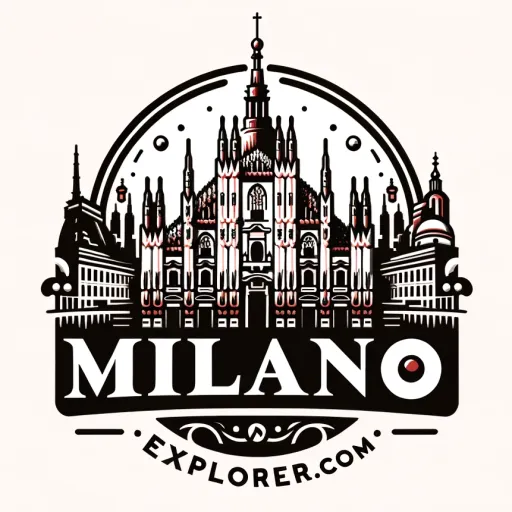At the turn of the 20th century, Milan blossomed into an epicenter of Art Nouveau, a style embodying elegance, natural forms, and intricate details. Known in Italy as ‘Stile Liberty,’ it was embraced by the city’s burgeoning industrial bourgeoisie with enthusiasm, reflecting their desire for modernity and distinction. The expression of Liberty style resonated through the city’s architecture, arts, and cultural identity, representing a distinctive period of creative fervor that shaped Milan’s urban landscape. In our exploration across Milan, we encounter treasured artifacts and buildings that continue to tell the story of how Milan Art Nouveau integrated into the stylistic lexicon of a cosmopolitan society.
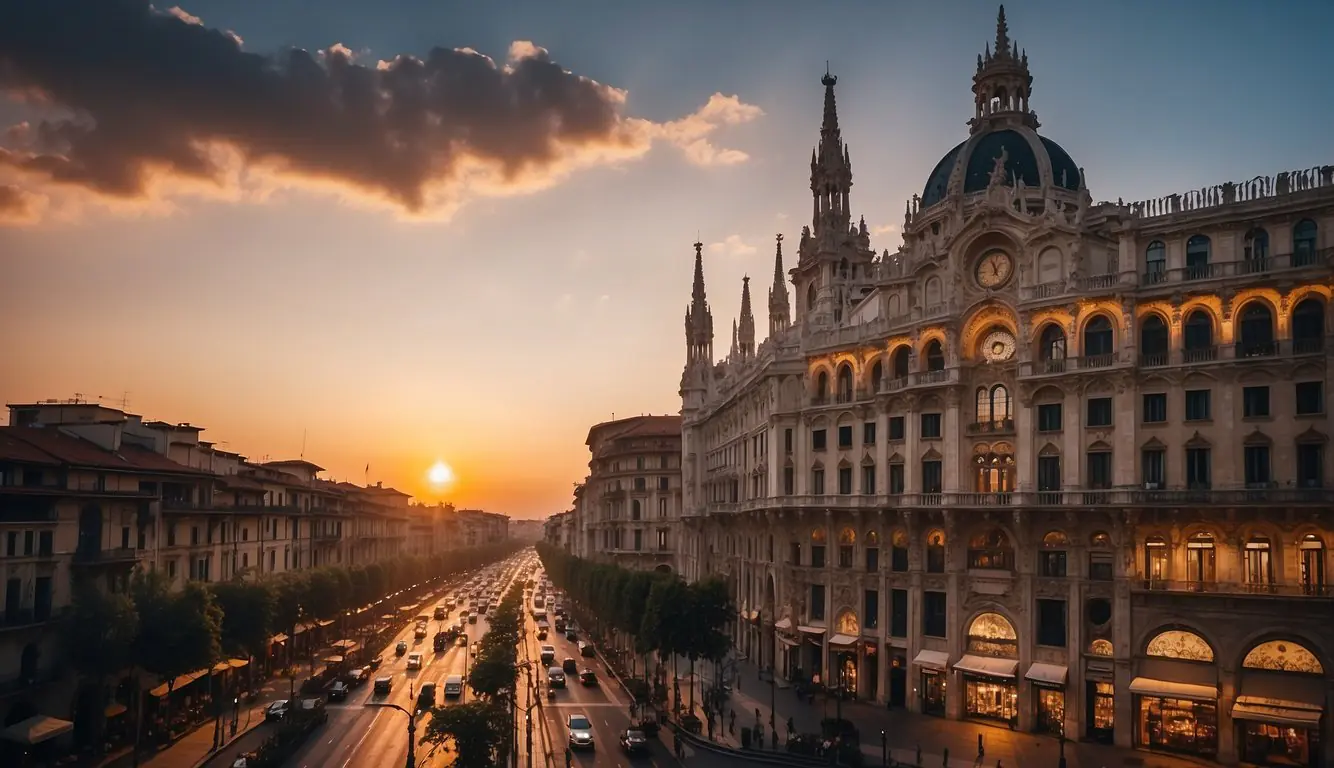
As an artistic movement, Art Nouveau in Milan was not just about aesthetics but a statement of innovation, blending curvature with symmetry in ways that complemented the rapid changes of the era. Esteemed architects like Giuseppe Sommaruga contributed significantly to the skyline with their modernist creations. One can embark on an Art Nouveau walk in Milan that showcases the masterpieces of the era, illustrating the city’s role as a canvas for this enchanting style. These edifices, adorned with ornate ironwork and elegant flourishes, remain as markers of a time when artistic expression boldly met the industrial progress of modern Milan.
As we reflect on the enduring influence of Art Nouveau, its significance extends beyond Milan, connecting the city to an international design movement that continues to captivate enthusiasts and scholars alike. This period in Milan’s history not only provided a visual feast for the eyes but also linked the city to a movement that spanned Europe, with repercussions that would reverberate through the ages in design and architecture. Our shared journey through Art Nouveau in Milan provides a window into the cultural dynamism that has long distinguished this Italian metropolis.
Milan Art Nouveau
Key Takeaways
- Art Nouveau, or Stile Liberty, was a defining artistic movement of early 20th-century Milan.
- Key architectural contributions were made by Giuseppe Sommaruga and other contemporaries.
- Milan’s adoption of Art Nouveau signaled its cultural and aesthetic alignment with Europe’s artistic evolution.
The Origins of Art Nouveau

Art Nouveau emerged as a dynamic, decorative style that swept through the fields of architecture, design, and art during the late 19th and early 20th centuries. Let’s explore the early influences that shaped this style and delve into its defining characteristics.
Early Influences in Art Nouveau
Art Nouveau didn’t appear in a vacuum; it was the result of a myriad of artistic and cultural shifts that aimed to break away from the rigid designs of the past. In Milan, the style known locally as Stile Liberty found resonance amongst the progressive industrial bourgeoisie. These early influences, which emphasized a departure from historical pastiche in favor of something more organic, helped set the stage for what Art Nouveau would become.
Another contributory factor originated from a group of reform-minded artists in Belgium, whose radical views on art were disseminated through publications such as L’Art Moderne. This laid the groundwork for the spread of Art Nouveau throughout Europe, including cities like Milan where the movement flourished especially in architecture.
Characteristics of Art Nouveau Design
The hallmark of Art Nouveau design is the use of long, flowing lines often taking the form of floral motifs and other natural forms. This can be identified in various forms of work, from the wrought iron detailing of gates and balconies to the elegant curves of graphic illustrations. These natural forms became synonymous with Art Nouveau, reflecting society’s fascination with the natural world as a response to the growing industrialization.
Design and architecture during this era focused not only on the aesthetic but also on the functional aspects of form. Influential architects of the Art Nouveau movement implemented these design elements to create harmonious and integrated buildings. Emblematic of the style are structures that combine the practical with the beautiful, making use of new materials like wrought iron and glass to create structures that were both modern and artistic.
Art Nouveau in Milan
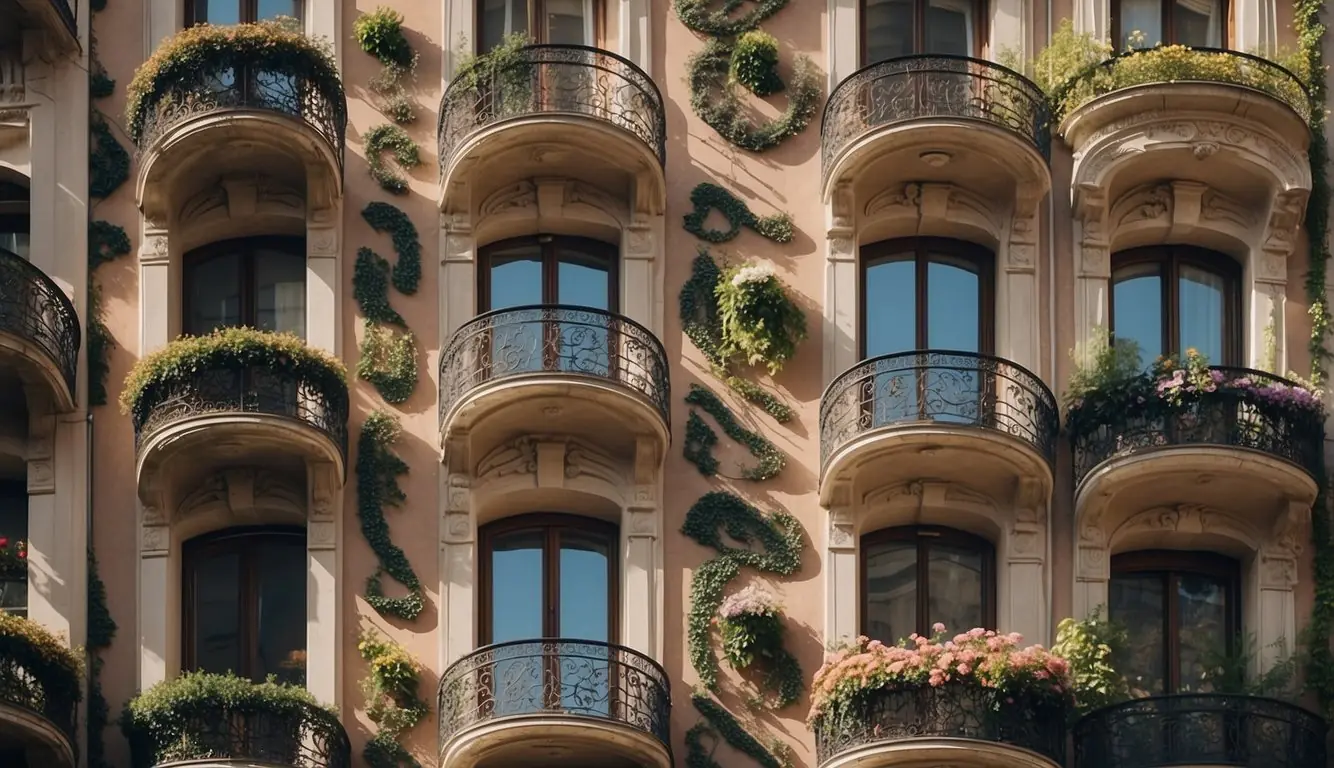
Art Nouveau, or Stile Liberty as it’s known in Italy, flourished in Milan in the early 20th century. This artistic movement is showcased through the city’s architectural marvels that blend natural forms with modern design.
Notable Architects and Their Works
Milan welcomed Art Nouveau with open arms, thanks to architects like Giuseppe Sommaruga and Alfredo Campanini. They designed buildings marked by intricate ironwork and floral motifs. Sommaruga’s contribution is particularly notable with masterpieces like the Palazzo Castiglioni and the renowned Casa Guazzoni. Campanini, on the other hand, is credited with the Casa Campanini, an embodiment of Milanese liberty style.
Milano’s Significant Art Nouveau Buildings
In Milan, numerous buildings stand out for their Art Nouveau design. For instance, Casa Galimberti showcases elaborate frescos and ironwork by artist Alessandro Mazzucotelli. The Civic Aquarium, another highlight, is a testament to Milan’s commitment to the Liberty style. Areas like Porta Venezia, Via Pisacane, and Corso Buenos Aires house these architectural gems, displaying the widespread adoption of Art Nouveau in the city. The Casa Berri Meregalli combines various styles but prominently features Stile Liberty elements.
Palazzo Castiglioni and Giuseppe Sommaruga
Our focus on Giuseppe Sommaruga leads us to one of his crowning achievements, the Palazzo Castiglioni. Constructed between 1901 and 1903, this palace stands proudly at Corso Venezia 47, near Piazza Argentina. The facade of Palazzo Castiglioni is adorned with statues and ornamentation that reveal the opulence and aesthetic innovation typical of Milan’s Art Nouveau movement. Sommaruga’s work on this building has set a high standard for other architects of his time and continues to be a source of inspiration.
The Expression of Liberty Style
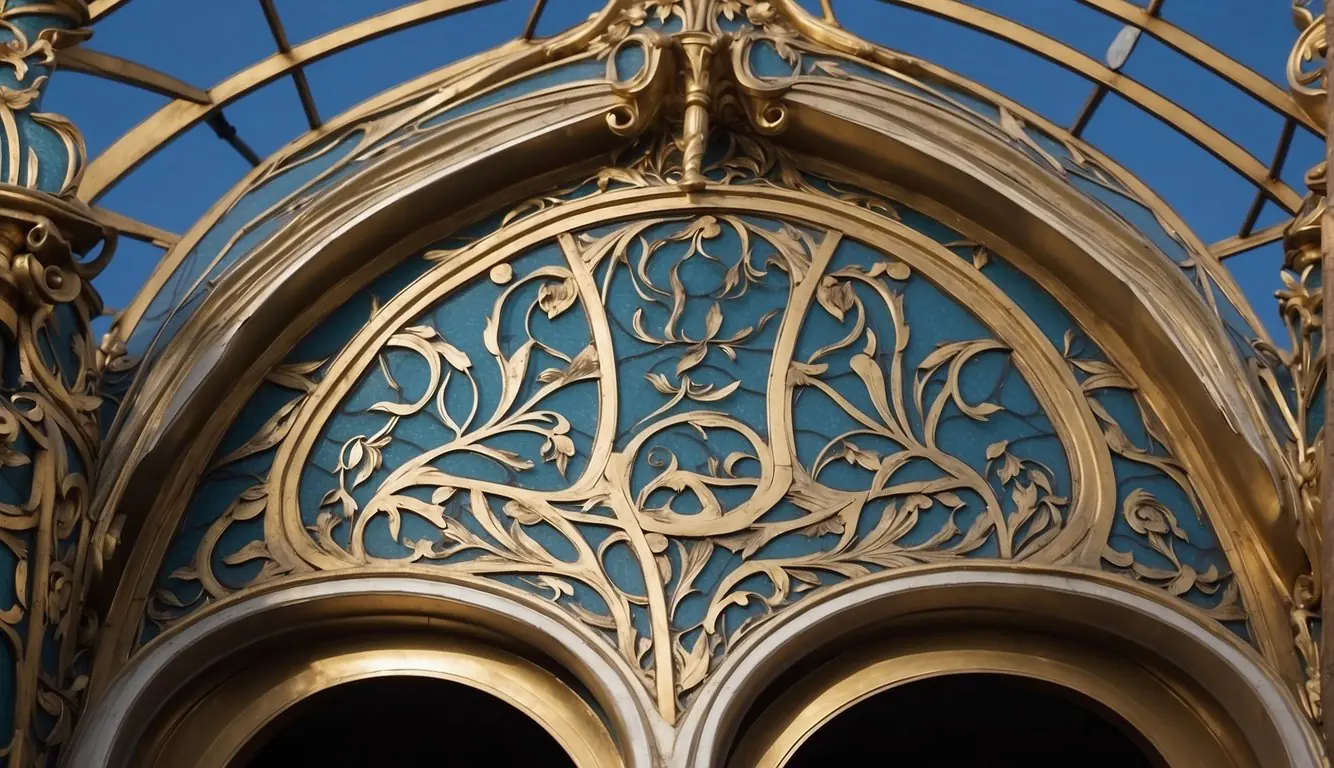
Liberty Style, also known as Stile Liberty, represents a formative era in Milan’s art scene. It exhibits the city’s vibrant cultural expansion, blending modernity with decorative finesse.
Art Nouveau and the Industrial Bourgeoisie
At the turn of the twentieth century, Milan witnessed an unprecedented blend of art and commerce. The rise of the industrial bourgeoisie offered fertile ground for Art Nouveau, labeled Stile Liberty in Italy, showcasing the wealth and progressive mindset of the era’s affluent class. Esteemed buildings adorned with wrought iron and intricate friezes became symbols of an aristocratic elegance, mirroring the success of the industrial elite. Our examination reveals how Liberty Style responded to the burgeoning desire for artistic expression among the industrial bourgeoisie, instigating a visual dialogue between commerce and creativity.
Distinctive Features of Liberty in Architecture
Stile Liberty’s uniqueness lies in its architectural features that distinctly merged functionality with aesthetic beauty. Using materials like wrought iron and cement, Liberty buildings often featured playful putti, rich floral motifs, and ornate balconies, elevating Milan’s urban landscape. With intricate mosaics and a penchant for eclecticism, this style seamlessly combined the new with the traditional. The fusion of these elements conveys Liberty’s spirit—innovative, yet firmly rooted in craftsmanship. Our fascination with the era is deepened by architects like Gaudi, who pushed the boundaries of functional art even further, demonstrating Liberty Style’s international resonance.
Through this exploration, we gain a comprehensive understanding of Liberty Style: a bold declaration of beauty, innovation, and industrial prowess in Milan’s evolutionary narrative.
Cultural Impact and Events
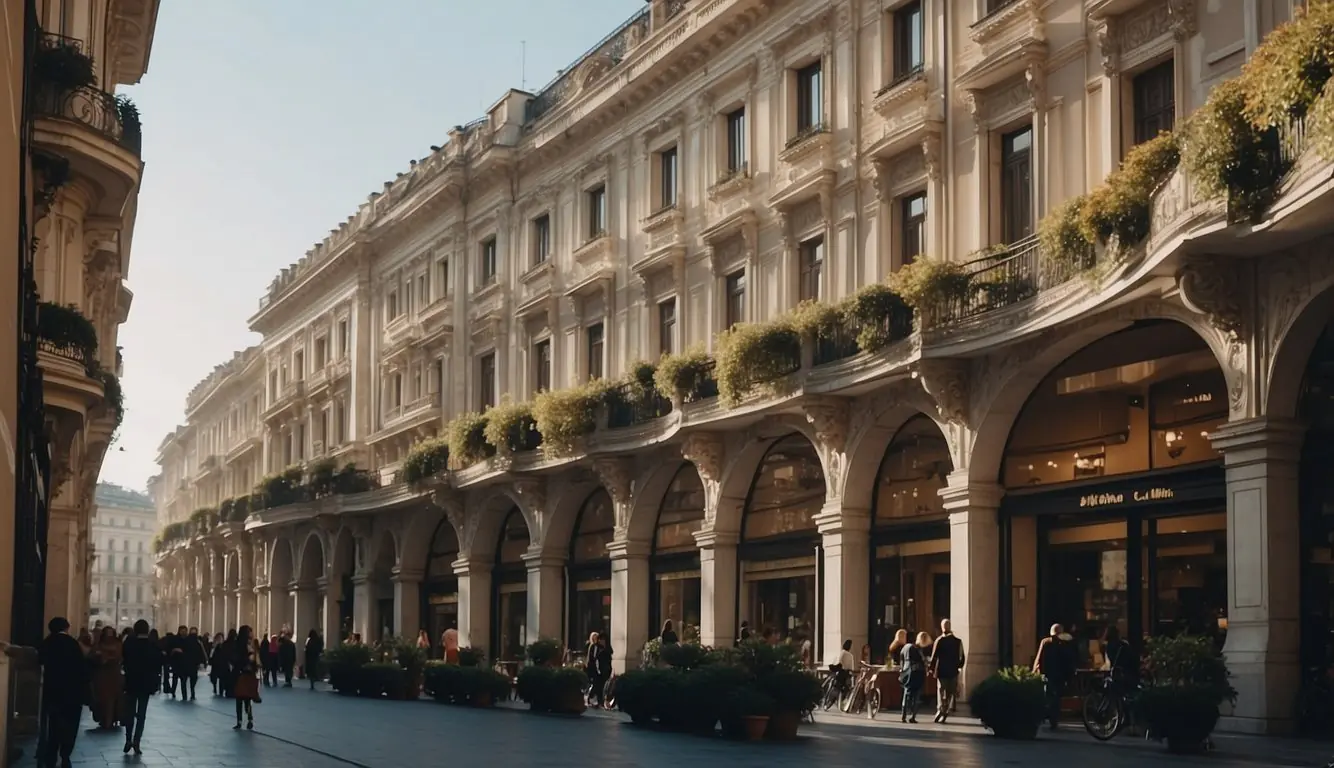
In Milan, Art Nouveau’s intricate designs and innovative style left a pronounced cultural imprint, creating a backdrop for a myriad of significant cultural events and contributing to a legacy that persists in the city’s efforts to preserve its historical beauty.
Art Nouveau’s Role in Cultural Events
Art Nouveau in Milan provided an aesthetic foundation for various cultural events that characterize the artistic vibrancy of the city. At the onset of the 20th century, this style’s fusion with the city’s industrial prosperity was evident during significant meetings and gatherings among the Milanese bourgeoisie. Gardens in Palermo, with their Art Nouveau architecture, have historically served as elegant venues for socializing and celebrating the Milanese elite’s affinity for the eclectic and artistic. These lush spaces became renowned for facilitating a cultural milieu where ideas and creativity flourished in North Italy.
Preserving the Art Nouveau Heritage
Our dedication to preserving the Art Nouveau heritage is demonstrated through the meticulous care of buildings like Casa Galimberti, which you can learn more about through exploring how Art Nouveau in Milan reflects the city’s past. In Varese, a town in close proximity to Milan, the preservation efforts have kept the spirit of Art Nouveau alive, ensuring continued admiration and study by future generations. Art Nouveau’s intricate details, and its fusion with local traditions in Varese, have been thoughtfully maintained, reminding us of the responsibility we carry to uphold these architectural treasures for their historical and artistic value.
Art Nouveau Beyond Milan

While Milan is a well-known hub for Art Nouveau, or Stile Liberty as it’s known in Italy, the movement’s influence extended beyond the city’s borders, finding its way through Northern Italy and into other prominent cities, each contributing a unique flair to the style.
Turin, Rome, and Other Art Nouveau Cities
Turin, known for its significance in the industrial growth of Italy, embraced Art Nouveau, interweaving it with its own aristocratic elegance. The city served as a perfect environment for this artistic style, which benefited immensely from the newfound wealth and innovative spirit that followed the construction of the Simplon Tunnel, a marvel that improved connectivity with the rest of Europe.
Rome, endowed with the prestige of the past and a constant desire to reinvent itself, offered a different canvas for Stile Liberty architects. They weaved Art Nouveau through the ancient city, injecting modernity into Rome’s classical heritage.
While lesser-known, other cities across Italy, from Palermo to Venice, also boast remarkable examples of Art Nouveau architecture, each interpreting the movement’s ethos in a way that melds with the local history and culture.
Exploring Art Nouveau Across Italy
As we journey through Italy, we discover a nation-wide fascination with Liberty. It’s evident that these cities, while sharing the common thread of Art Nouveau, have tailored the movement to their respective aesthetic and cultural contexts. Northern Italy, with its proximity to other European Art Nouveau centers, shows a particularly diverse adoption of the style, creating a rich tapestry of design and architecture.
Our exploration reveals a country where Art Nouveau didn’t just arrive, it thrived and transformed, influencing everything from urban landmarks to domestic homes, embedding itself into the fabric of Italian modernity.
Artistic Elements and Decorations
Our exploration of Art Nouveau in Milan reveals a rich tapestry of ornamental elements and groundbreaking designs. The city’s architecture becomes a canvas where wrought iron gracefully intertwines with vivid mosaics and stained glass windows, bringing to life the artistry of the era.
Sculpture and Ironwork in Art Nouveau
Milan celebrates the seamless integration of art and architecture through the work of notable figures like sculptor Ernesto Bazzaro. His talent in crafting expressive female statues lends a distinctive character to the buildings adorned with his work. We see the organic curvature typical of Art Nouveau in the complex wrought iron designs that accentuate Milanese facades. These metal sculptures often create a dynamic flow, merging structural functionality with aesthetic splendor.
Glass and Mosaic Work in Art Nouveau Design
In the realm of mosaics and stained glass, Milan’s Art Nouveau shines with innovation. Mosaic designs featuring iridescent tiles capture the essence of naturalism and symbolism, central to Art Nouveau aesthetics. Stained glass windows further enrich the style by casting rooms in colorful, ambient light, transforming the visual experience within Art Nouveau spaces. These elements not only serve as decoration but also illustrate the harmonious blend of form and function valued by Milanese architects.
Enduring Influence of Art Nouveau

As we explore the Art Nouveau movement’s lasting impact, it’s evident that its distinct aesthetic still resonates. Within Milan’s architectural sphere, structures like Casa Galimberti showcase this enduring style.
Modern Day Appreciation of Art Nouveau
Art Nouveau, or Stile Liberty as it’s known in Italy, has been preserved and valued through various edifices in Milan. A notable example is Casa Galimberti, adorned with intricate floral motifs and sinuous lines that capture the essence of the movement. The careful restoration and upkeep of such landmarks, including Casa Agostoni and Casa Alessio, highlight our continued appreciation for Art Nouveau’s contribution to urban landscapes.
Art Nouveau in Contemporary Design
In contemporary design, the influence of Art Nouveau can be seen in the fluidity and organic forms of modern typography and layout. This is evident in today’s branding and packaging, where the integration of visual arts is paramount. Observing details like the exquisite glasswork of Edicola Giudici leads us to value Art Nouveau’s contribution to the harmony of form and function in current design practices.
Conclusion
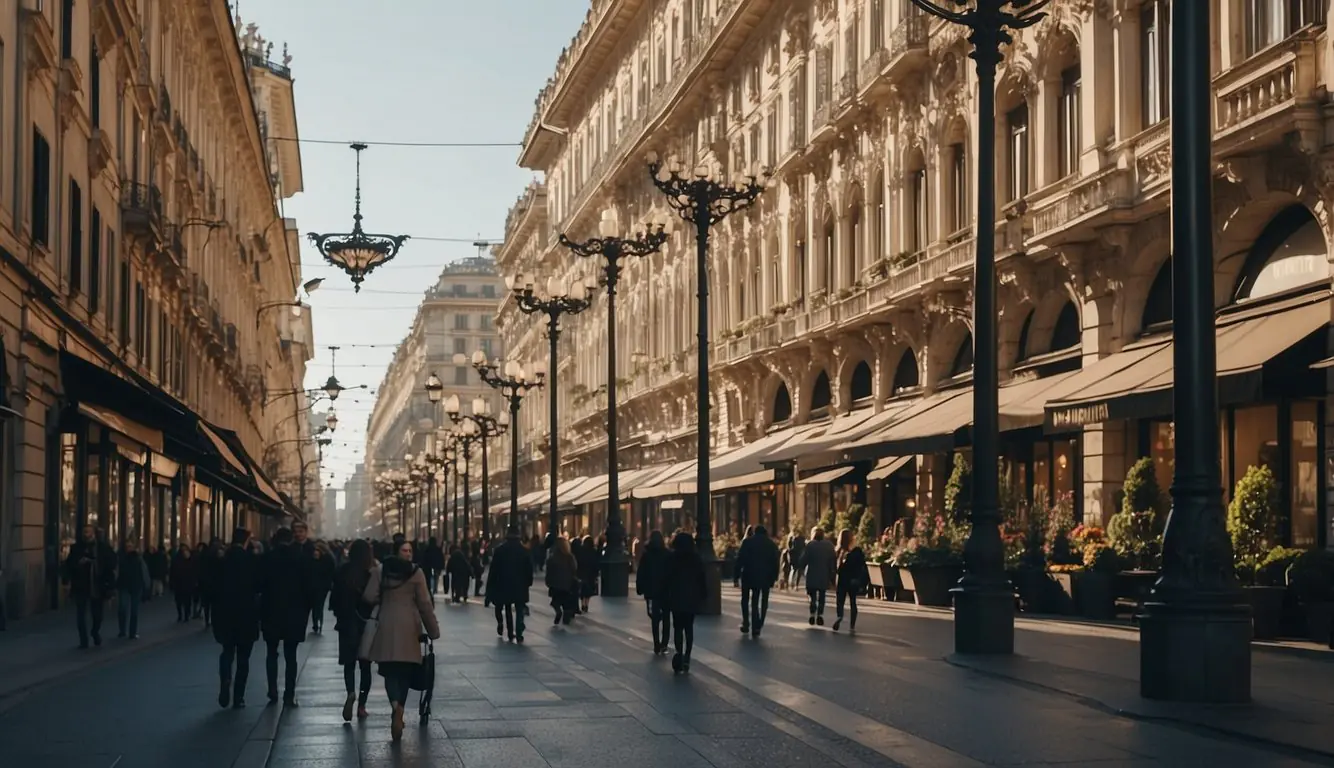
In Milan, the transition from Art Nouveau to other architectural styles marks a significant evolution in our urban landscape. The Milan Central Station is a testament to this shift, showcasing a blend of late-eclectic style with Art Deco decorations and modernist influences. It represents the culmination of Art Nouveau’s presence in our city, giving way to the emergence of Art Deco and Italian Novecento.
Within central Milan, we proudly point to Parco Sempione as a hub for Art Nouveau’s legacy. The park hosts a striking Art Nouveau building that presents the city’s aquarium—a piece of our architectural heritage. Similarly, the Triennale design museum stands out as another cornerstone, anchoring the western end with its historical significance.
We must also celebrate the dedicated areas like Porta Venezia, known as the Art Nouveau quarter of Milan. Here, the architectural style flourishes with rich details such as wrought iron and tile decorations that shine a spotlight on Art Nouveau’s distinctive features: floral motifs, elegant lines, and a blend of form and function.
Our journey through Art Nouveau’s influence in Milan underlines a commitment to innovation melded with an appreciation for aesthetic intricacies. It defines not just our buildings, but our collective identity in the architectural world.
As we walk through the streets of Milan, we are continually reminded of the impact that Art Nouveau has had on the city’s character—each building, a narrative of our cultural and historical fabric.
Frequently Asked Questions
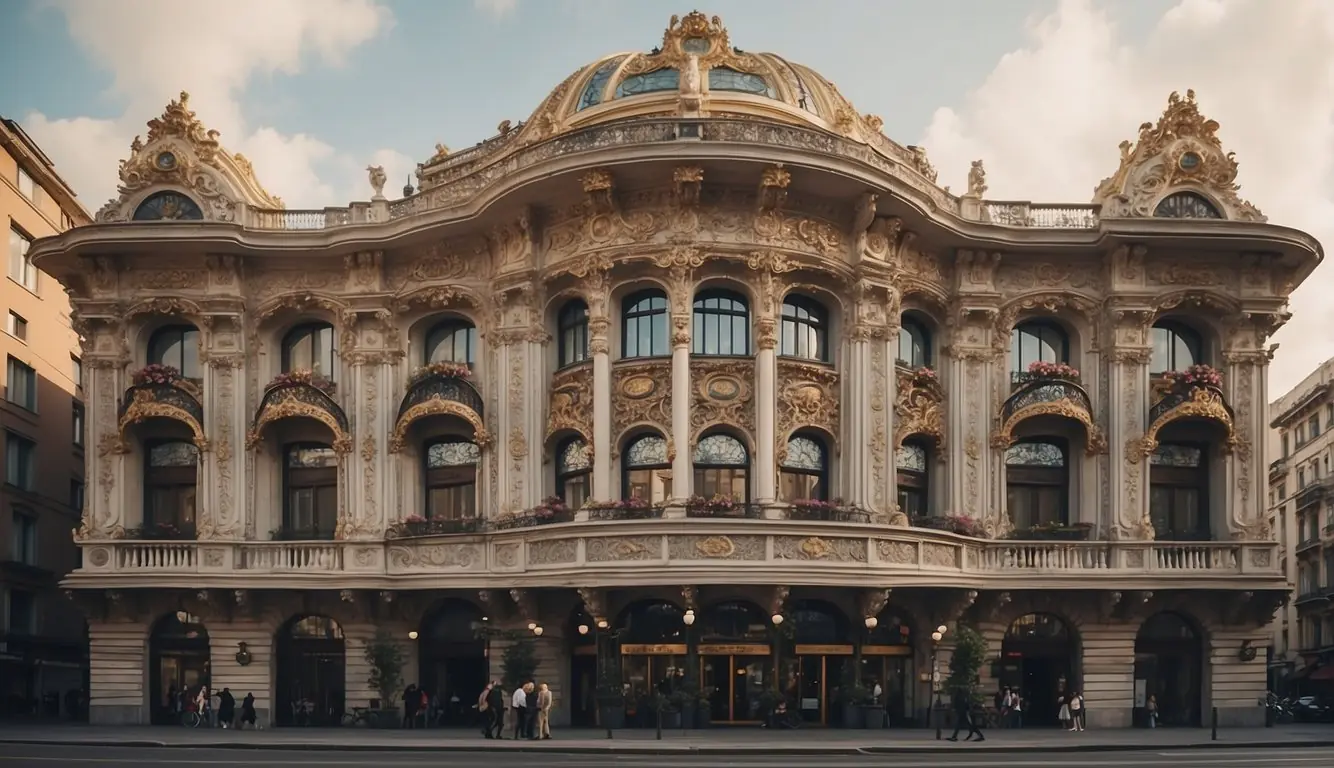
In the following section, we address the most pressing inquiries about Milan’s distinct Art Nouveau movement, exploring prominent artists, architectural landmarks, and the unique characteristics that define this celebrated era of design.
Who are the key Italian Art Nouveau artists and how did they contribute to the style?
Art Nouveau in Milan was marked by the works of artists such as Giuseppe Sommaruga, whose contributions included stunning villas that embodied the style’s organic motifs and flowing lines. The Casa Galimberti is adorned with elaborate floral decorations and exemplifies the craftsmanship of Italian Art Nouveau artisans.
How did Art Nouveau influence the architecture and design in Milan?
In Milan, Art Nouveau, or Stile Liberty, saw a burgeoning within the city’s architectural realms, particularly among the bourgeoisie. Ornate ironwork and colorful tiles became hallmarks of this movement, fostering a distinct aesthetic throughout neighborhoods like Porta Venezia—a testament to the movement’s influence on Milan’s cityscape.
What are some significant examples of Art Nouveau buildings or homes in Milan?
Significant buildings and homes in Milan that exemplify Art Nouveau include the Casa Galimberti and Casa Guazzoni. Their facades showcase ornate frescoes and intricate ironwork, making them prominent landmarks within the city’s architectural heritage.
How do Art Nouveau and Art Deco differ within the context of Italy’s art history?
Art Nouveau and Art Deco differ significantly; Art Nouveau featured organic and flowing forms, while Art Deco moved towards geometric shapes and vibrant colors following World War I. In Italy, these styles reflected shifts in societal values and artistic tastes, transitioning from the past’s ornamentation to a more modern and streamlined design. Learn more about these differences here.
In what way did the Art Nouveau movement manifest in Milan compared to other European cities?
While Art Nouveau appeared across Europe, Milan’s manifestation of the style was characterized by its close ties to the city’s industrial growth and the embrace of modernity in design. Unlike the more restrained interpretations in some regions, Milanese Art Nouveau, or Stile Liberty, flourished with flamboyance and expressive decorative elements.
What historical factors led to the emergence of Art Nouveau in Milan?
The emergence of Art Nouveau in Milan was propelled by the city’s rapidly expanding industrial economy and a burgeoning middle class eager to express their wealth through contemporary architecture and design. This period of economic prosperity enabled a fertile environment for the Art Nouveau aesthetic to take root and flourish.
